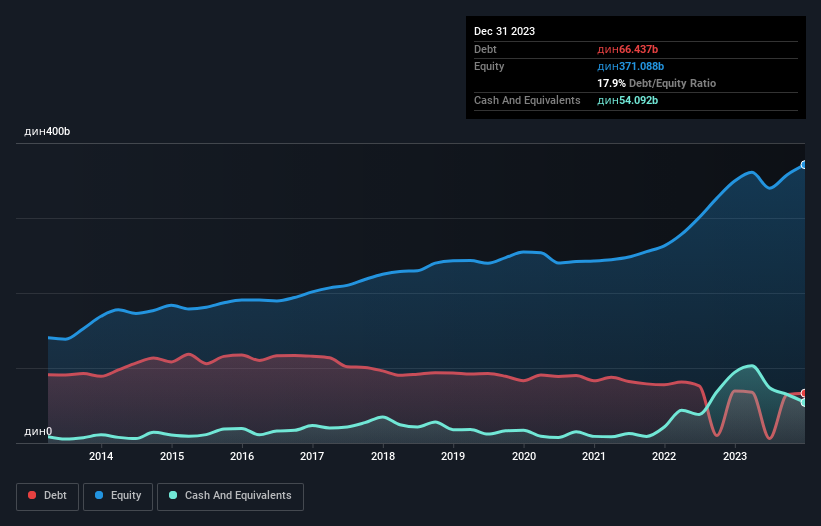- Serbia
- /
- Oil and Gas
- /
- BELEX:NIIS
We Think Naftna Industrija Srbije a.d (BELEX:NIIS) Can Stay On Top Of Its Debt

The external fund manager backed by Berkshire Hathaway's Charlie Munger, Li Lu, makes no bones about it when he says 'The biggest investment risk is not the volatility of prices, but whether you will suffer a permanent loss of capital.' So it might be obvious that you need to consider debt, when you think about how risky any given stock is, because too much debt can sink a company. Importantly, Naftna Industrija Srbije a.d. (BELEX:NIIS) does carry debt. But should shareholders be worried about its use of debt?
When Is Debt A Problem?
Generally speaking, debt only becomes a real problem when a company can't easily pay it off, either by raising capital or with its own cash flow. If things get really bad, the lenders can take control of the business. However, a more common (but still painful) scenario is that it has to raise new equity capital at a low price, thus permanently diluting shareholders. Of course, the upside of debt is that it often represents cheap capital, especially when it replaces dilution in a company with the ability to reinvest at high rates of return. When we think about a company's use of debt, we first look at cash and debt together.
See our latest analysis for Naftna Industrija Srbije a.d
What Is Naftna Industrija Srbije a.d's Net Debt?
You can click the graphic below for the historical numbers, but it shows that Naftna Industrija Srbije a.d had дин66.4b of debt in December 2023, down from дин69.3b, one year before. On the flip side, it has дин54.1b in cash leading to net debt of about дин12.3b.

A Look At Naftna Industrija Srbije a.d's Liabilities
The latest balance sheet data shows that Naftna Industrija Srbije a.d had liabilities of дин63.2b due within a year, and liabilities of дин72.4b falling due after that. Offsetting this, it had дин54.1b in cash and дин34.1b in receivables that were due within 12 months. So it has liabilities totalling дин47.4b more than its cash and near-term receivables, combined.
While this might seem like a lot, it is not so bad since Naftna Industrija Srbije a.d has a market capitalization of дин138.6b, and so it could probably strengthen its balance sheet by raising capital if it needed to. But it's clear that we should definitely closely examine whether it can manage its debt without dilution.
We measure a company's debt load relative to its earnings power by looking at its net debt divided by its earnings before interest, tax, depreciation, and amortization (EBITDA) and by calculating how easily its earnings before interest and tax (EBIT) cover its interest expense (interest cover). The advantage of this approach is that we take into account both the absolute quantum of debt (with net debt to EBITDA) and the actual interest expenses associated with that debt (with its interest cover ratio).
Naftna Industrija Srbije a.d has net debt of just 0.18 times EBITDA, suggesting it could ramp leverage without breaking a sweat. And remarkably, despite having net debt, it actually received more in interest over the last twelve months than it had to pay. So there's no doubt this company can take on debt while staying cool as a cucumber. It is just as well that Naftna Industrija Srbije a.d's load is not too heavy, because its EBIT was down 63% over the last year. Falling earnings (if the trend continues) could eventually make even modest debt quite risky. The balance sheet is clearly the area to focus on when you are analysing debt. But ultimately the future profitability of the business will decide if Naftna Industrija Srbije a.d can strengthen its balance sheet over time. So if you're focused on the future you can check out this free report showing analyst profit forecasts.
Finally, while the tax-man may adore accounting profits, lenders only accept cold hard cash. So the logical step is to look at the proportion of that EBIT that is matched by actual free cash flow. Over the most recent three years, Naftna Industrija Srbije a.d recorded free cash flow worth 50% of its EBIT, which is around normal, given free cash flow excludes interest and tax. This cold hard cash means it can reduce its debt when it wants to.
Our View
Naftna Industrija Srbije a.d's EBIT growth rate was a real negative on this analysis, although the other factors we considered were considerably better. There's no doubt that its ability to to cover its interest expense with its EBIT is pretty flash. Looking at all this data makes us feel a little cautious about Naftna Industrija Srbije a.d's debt levels. While debt does have its upside in higher potential returns, we think shareholders should definitely consider how debt levels might make the stock more risky. When analysing debt levels, the balance sheet is the obvious place to start. However, not all investment risk resides within the balance sheet - far from it. For example, we've discovered 3 warning signs for Naftna Industrija Srbije a.d (1 is potentially serious!) that you should be aware of before investing here.
Of course, if you're the type of investor who prefers buying stocks without the burden of debt, then don't hesitate to discover our exclusive list of net cash growth stocks, today.
Valuation is complex, but we're here to simplify it.
Discover if Naftna Industrija Srbije a.d might be undervalued or overvalued with our detailed analysis, featuring fair value estimates, potential risks, dividends, insider trades, and its financial condition.
Access Free AnalysisHave feedback on this article? Concerned about the content? Get in touch with us directly. Alternatively, email editorial-team (at) simplywallst.com.
This article by Simply Wall St is general in nature. We provide commentary based on historical data and analyst forecasts only using an unbiased methodology and our articles are not intended to be financial advice. It does not constitute a recommendation to buy or sell any stock, and does not take account of your objectives, or your financial situation. We aim to bring you long-term focused analysis driven by fundamental data. Note that our analysis may not factor in the latest price-sensitive company announcements or qualitative material. Simply Wall St has no position in any stocks mentioned.
About BELEX:NIIS
Naftna Industrija Srbije a.d
An integrated oil company, engages in the exploration, development, and production of crude oil and gas in Serbia.
Flawless balance sheet second-rate dividend payer.
Market Insights
Community Narratives



